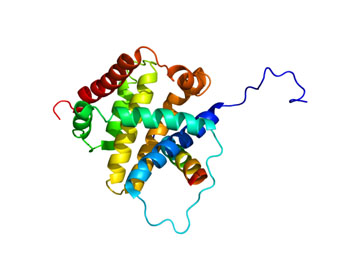Levels of Bim Protein in T-cells Reflect Success of Anti–PD-1 Cancer Therapy
|
By LabMedica International staff writers Posted on 16 May 2016 |

Image: A structural model of the Bim protein (Photo courtesy of Wikimedia Commons).
Measurement of levels of Bim (BCL-2-interacting mediator of cell death) protein in circulating T-cells of cancer patients may provide a less invasive strategy to predict and monitor responses to anti–PD-1 therapy.
Immune checkpoint therapy with PD-1 (Programmed cell death protein 1) blockade has emerged as an effective therapy for many advanced cancers; however, only a small fraction of patients achieve long-term responses. There is no validated blood-based means of predicting the response to PD-1 blockade.
PD-1, functioning as an immune checkpoint, plays an important role in down regulating the immune system by preventing the activation of T-cells, which in turn reduces autoimmunity and promotes self-tolerance. The inhibitory effect of PD-1 is accomplished through a dual mechanism of promoting apoptosis (programmed cell death) in antigen specific T-cells in lymph nodes while simultaneously reducing apoptosis in regulatory T cells (suppressor T cells).
Investigators at the Mayo Clinic (Rochester, MN, USA) had previously cloned PD-L1 (Programmed death-ligand 1) and found that tumor-associated PD-L1 mediated tumor immune evasion. Since then the group has been working on dissecting the molecular mechanisms of the PD-L1/PD-1 pathway in T-cell dysfunction.
They recently reported that they had identified the protein Bim as a downstream signaling molecule of the PD-1 pathway and that its detection in T-cells was significantly associated with expression of PD-1 and effector T-cell markers. Thus, high levels of Bim in circulating tumor-reactive T-cells were prognostic of poor survival in patients with metastatic melanoma who did not receive anti–PD-1 therapy and were also predictive of clinical benefit in patients with metastatic melanoma who received anti–PD-1 therapy in the form of the humanized monoclonal antibody drug pembrolizumab. This circulating tumor-reactive T-cell population significantly decreased after successful anti–PD-1 therapy.
"Our previous research demonstrated that Bim is a downstream signaling molecule in the PD-1 signaling pathway, and that levels of Bim reflect the degree of PD-1 interaction with its ligand PD-L1," said senior author Dr. Haidong Dong, associate professor of immunology at the Mayo Clinic. "We hypothesized that the increased frequency of CD8+PD-1+Bim+T cells in patients who respond to immunotherapy reflects an increased number of target T-cells for PD-1 blockade with pembrolizumab, which may explain the positive clinical outcomes in these patients."
The study was published in the May 5, 2016, online edition of the journal JCI Insight.
Related Links:
Mayo Clinic
Immune checkpoint therapy with PD-1 (Programmed cell death protein 1) blockade has emerged as an effective therapy for many advanced cancers; however, only a small fraction of patients achieve long-term responses. There is no validated blood-based means of predicting the response to PD-1 blockade.
PD-1, functioning as an immune checkpoint, plays an important role in down regulating the immune system by preventing the activation of T-cells, which in turn reduces autoimmunity and promotes self-tolerance. The inhibitory effect of PD-1 is accomplished through a dual mechanism of promoting apoptosis (programmed cell death) in antigen specific T-cells in lymph nodes while simultaneously reducing apoptosis in regulatory T cells (suppressor T cells).
Investigators at the Mayo Clinic (Rochester, MN, USA) had previously cloned PD-L1 (Programmed death-ligand 1) and found that tumor-associated PD-L1 mediated tumor immune evasion. Since then the group has been working on dissecting the molecular mechanisms of the PD-L1/PD-1 pathway in T-cell dysfunction.
They recently reported that they had identified the protein Bim as a downstream signaling molecule of the PD-1 pathway and that its detection in T-cells was significantly associated with expression of PD-1 and effector T-cell markers. Thus, high levels of Bim in circulating tumor-reactive T-cells were prognostic of poor survival in patients with metastatic melanoma who did not receive anti–PD-1 therapy and were also predictive of clinical benefit in patients with metastatic melanoma who received anti–PD-1 therapy in the form of the humanized monoclonal antibody drug pembrolizumab. This circulating tumor-reactive T-cell population significantly decreased after successful anti–PD-1 therapy.
"Our previous research demonstrated that Bim is a downstream signaling molecule in the PD-1 signaling pathway, and that levels of Bim reflect the degree of PD-1 interaction with its ligand PD-L1," said senior author Dr. Haidong Dong, associate professor of immunology at the Mayo Clinic. "We hypothesized that the increased frequency of CD8+PD-1+Bim+T cells in patients who respond to immunotherapy reflects an increased number of target T-cells for PD-1 blockade with pembrolizumab, which may explain the positive clinical outcomes in these patients."
The study was published in the May 5, 2016, online edition of the journal JCI Insight.
Related Links:
Mayo Clinic
Latest Pathology News
- Rapid Low-Cost Tests Can Prevent Child Deaths from Contaminated Medicinal Syrups
- Tumor Signals in Saliva and Blood Enable Non-Invasive Monitoring of Head and Neck Cancer
- Common Health Issues Can Influence New Blood Tests for Alzheimer’s Disease
- Blood Test Formula Identifies Chronic Liver Disease Patients with Higher Cancer Risk
- Tunable Cell-Sorting Device Holds Potential for Multiple Biomedical Applications
- AI Tool Outperforms Doctors in Spotting Blood Cell Abnormalities
- AI Tool Rapidly Analyzes Complex Cancer Images for Personalized Treatment
- Diagnostic Technology Performs Rapid Biofluid Analysis Using Single Droplet
- Novel Technology Tracks Hidden Cancer Cells Faster
- AI Tool Improves Breast Cancer Detection
- AI Tool Predicts Treatment Success in Rectal Cancer Patients
- Blood Test and Sputum Analysis Predict Acute COPD Exacerbation
- AI Tool to Transform Skin Cancer Detection with Near-Perfect Accuracy
- Unique Immune Signatures Distinguish Rare Autoimmune Condition from Multiple Sclerosis
- Simple Optical Microscopy Method Reveals Hidden Structures in Remarkable Detail
- Hydrogel-Based Technology Isolates Extracellular Vesicles for Early Disease Diagnosis
Channels
Clinical Chemistry
view channel
Online Tool Detects Drug Exposure Directly from Patient Samples
Doctors often rely on patient interviews and medical records to determine what medications a person has taken, but this information is frequently incomplete. People may forget drugs they used, take over-the-counter... Read more
Chemical Imaging Probe Could Track and Treat Prostate Cancer
Prostate cancer remains a leading cause of illness and death among men, with many patients eventually developing resistance to standard hormone-blocking therapies. These drugs often lose effectiveness... Read moreMolecular Diagnostics
view channel
New 15-Minute Hepatitis C Test Paves Way for Same-Day Treatment
Chronic hepatitis C infection affects an estimated 50 million people worldwide and causes around 242,000 deaths each year, largely due to cirrhosis and liver cancer. Although the infection is curable with... Read more
Ovarian Cancer Assay Outperforms Traditional Tests in Early Disease Detection
Globally, ovarian cancer is one of the deadliest cancers affecting women. Traditionally, early diagnosis of ovarian cancer has been challenging. Many ovarian cancers are diagnosed only after they have... Read moreHematology
view channel
MRD Tests Could Predict Survival in Leukemia Patients
Acute myeloid leukemia is an aggressive blood cancer that disrupts normal blood cell production and often relapses even after intensive treatment. Clinicians currently lack early, reliable markers to predict... Read more
Platelet Activity Blood Test in Middle Age Could Identify Early Alzheimer’s Risk
Early detection of Alzheimer’s disease remains one of the biggest unmet needs in neurology, particularly because the biological changes underlying the disorder begin decades before memory symptoms appear.... Read more
Microvesicles Measurement Could Detect Vascular Injury in Sickle Cell Disease Patients
Assessing disease severity in sickle cell disease (SCD) remains challenging, especially when trying to predict hemolysis, vascular injury, and risk of complications such as vaso-occlusive crises.... Read more
ADLM’s New Coagulation Testing Guidance to Improve Care for Patients on Blood Thinners
Direct oral anticoagulants (DOACs) are one of the most common types of blood thinners. Patients take them to prevent a host of complications that could arise from blood clotting, including stroke, deep... Read moreImmunology
view channel
Routine Blood Test Can Predict Who Benefits Most from CAR T-Cell Therapy
CAR T-cell therapy has transformed treatment for patients with relapsed or treatment-resistant non-Hodgkin lymphoma, but many patients eventually relapse despite an initial response. Clinicians currently... Read more
New Test Distinguishes Vaccine-Induced False Positives from Active HIV Infection
Since HIV was identified in 1983, more than 91 million people have contracted the virus, and over 44 million have died from related causes. Today, nearly 40 million individuals worldwide live with HIV-1,... Read more
Gene Signature Test Predicts Response to Key Breast Cancer Treatment
DK4/6 inhibitors paired with hormone therapy have become a cornerstone treatment for advanced HR+/HER2– breast cancer, slowing tumor growth by blocking key proteins that drive cell division.... Read more
Chip Captures Cancer Cells from Blood to Help Select Right Breast Cancer Treatment
Ductal carcinoma in situ (DCIS) accounts for about a quarter of all breast cancer cases and generally carries a good prognosis. This non-invasive form of the disease may or may not become life-threatening.... Read moreMicrobiology
view channel
Blood-Based Diagnostic Method Could Identify Pediatric LRTIs
Lower-respiratory tract infections (LRTIs) are a leading cause of illness and death worldwide, and pneumonia is the leading infectious cause of death in children under five, claiming the lives of over... Read more
Rapid Diagnostic Test Matches Gold Standard for Sepsis Detection
Sepsis kills 11 million people worldwide every year and generates massive healthcare costs. In the USA and Europe alone, sepsis accounts for USD 100 billion in annual hospitalization expenses.... Read moreRapid POC Tuberculosis Test Provides Results Within 15 Minutes
Tuberculosis remains one of the world’s deadliest infectious diseases, and reducing new cases depends on identifying individuals with latent infection before it progresses. Current diagnostic tools often... Read more
Rapid Assay Identifies Bloodstream Infection Pathogens Directly from Patient Samples
Bloodstream infections in sepsis progress quickly and demand rapid, precise diagnosis. Current blood-culture methods often take one to five days to identify the pathogen, leaving clinicians to treat blindly... Read moreTechnology
view channel
Machine Learning Models Diagnose ALS Earlier Through Blood Biomarkers
Amyotrophic lateral sclerosis (ALS) is a rapidly progressive neurodegenerative disease that is notoriously difficult to diagnose in its early stages. Early symptoms often overlap with other neurological... Read more
Artificial Intelligence Model Could Accelerate Rare Disease Diagnosis
Identifying which genetic variants actually cause disease remains one of the biggest challenges in genomic medicine. Each person carries tens of thousands of DNA changes, yet only a few meaningfully alter... Read moreIndustry
view channel
Abbott Acquires Cancer-Screening Company Exact Sciences
Abbott (Abbott Park, IL, USA) has entered into a definitive agreement to acquire Exact Sciences (Madison, WI, USA), enabling it to enter and lead in fast-growing cancer diagnostics segments.... Read more



















